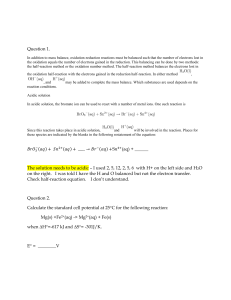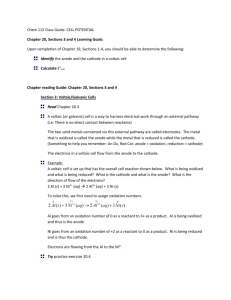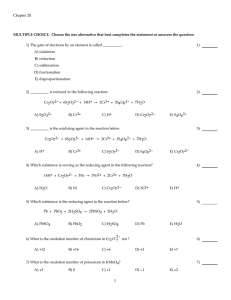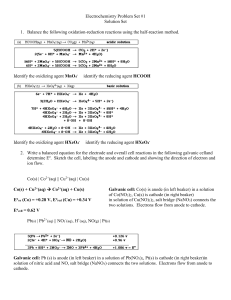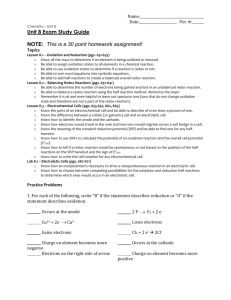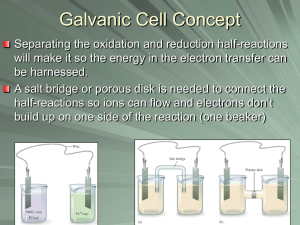Unit C Assignment 1 - Rocky View Schools Moodle 2
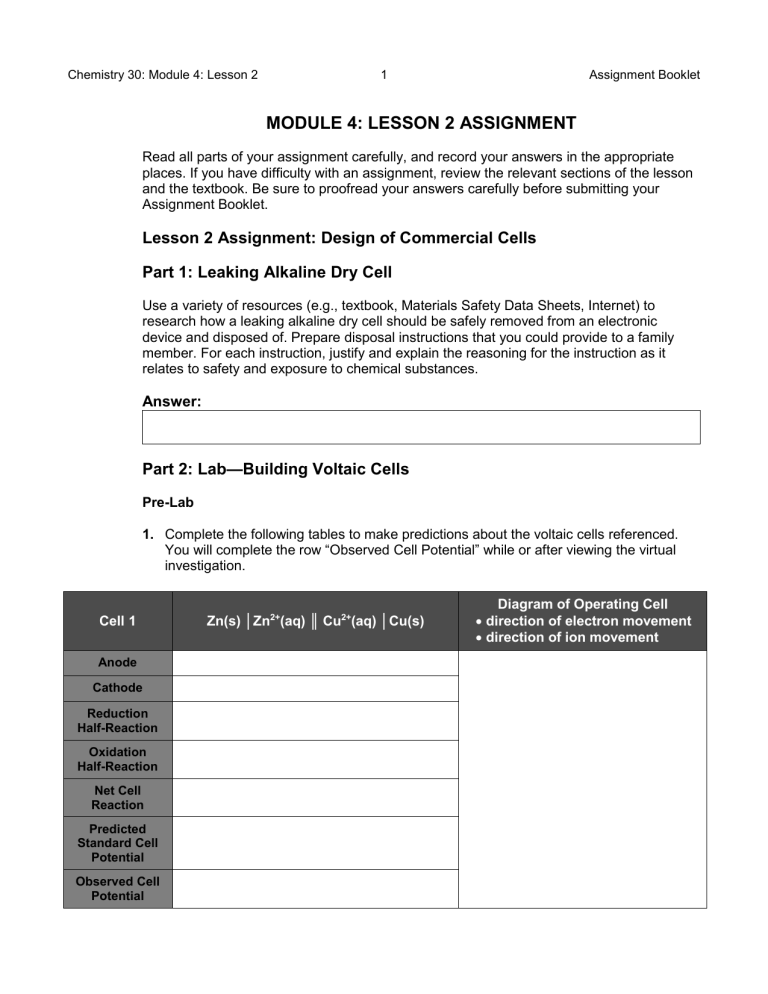
Chemistry 30: Module 4: Lesson 2 1 Assignment Booklet
Cell 1
Anode
Cathode
Reduction
Half-Reaction
Oxidation
Half-Reaction
Net Cell
Reaction
Predicted
Standard Cell
Potential
Observed Cell
Potential
MODULE 4: LESSON 2 ASSIGNMENT
Read all parts of your assignment carefully, and record your answers in the appropriate places. If you have difficulty with an assignment, review the relevant sections of the lesson and the textbook. Be sure to proofread your answers carefully before submitting your
Assignment Booklet.
Lesson 2 Assignment: Design of Commercial Cells
Part 1: Leaking Alkaline Dry Cell
Use a variety of resources (e.g., textbook, Materials Safety Data Sheets, Internet) to research how a leaking alkaline dry cell should be safely removed from an electronic device and disposed of. Prepare disposal instructions that you could provide to a family member. For each instruction, justify and explain the reasoning for the instruction as it relates to safety and exposure to chemical substances.
Answer:
Part 2: Lab —Building Voltaic Cells
Pre-Lab
1. Complete the following tables to make predictions about the voltaic cells referenced.
You will complete the row “Observed Cell Potential” while or after viewing the virtual investigation.
Zn(s) │Zn 2+ (aq) ║ Cu 2+ (aq) │Cu(s)
Diagram of Operating Cell
direction of electron movement
direction of ion movement
Chemistry 30: Module 4: Lesson 2 2 Assignment Booklet
Spontaneous
(Yes or No)
Cell 2 Zn(s) │Zn 2+ (aq) ║ Fe 2+ (aq) │Fe(s)
Anode
Cathode
Reduction
Half-Reaction
Oxidation
Half-Reaction
Net Cell
Reaction
Predicted
Standard Cell
Potential
Observed Cell
Potential
Spontaneous
(Yes or No)
Cell 3 Fe(s) │Fe 2+ (aq) ║ Cu 2+ (aq) │Cu(s)
Anode
Cathode
Reduction
Half-Reaction
Oxidation
Half-Reaction
Net Cell
Reaction
Predicted
Standard Cell
Potential
Observed Cell
Potential
Spontaneous
(Yes or No)
Diagram of Operating Cell
direction of electron movement
direction of ion movement
Diagram of Operating Cell
direction of electron movement
direction of ion movement
Chemistry 30: Module 4: Lesson 2 3 Assignment Booklet
Cell 4 Mg(s) │Mg 2+ (aq) ║ Zn 2+ (aq) │Zn(s)
Anode
Cathode
Reduction
Half-Reaction
Oxidation
Half-Reaction
Net Cell
Reaction
Predicted
Standard Cell
Potential
Observed Cell
Potential
Spontaneous
(Yes or No)
Cell 5 Mg(s) │Mg 2+ (aq) ║ Fe 2+ (aq) │Fe(s)
Anode
Cathode
Reduction
Half-Reaction
Oxidation
Half-Reaction
Net Cell
Reaction
Predicted
Standard Cell
Potential
Observed Cell
Potential
Spontaneous
(Yes or No)
Diagram of Operating Cell
direction of electron movement
direction of ion movement
Diagram of Operating Cell
direction of electron movement
direction of ion movement
Chemistry 30: Module 4: Lesson 2 4 Assignment Booklet
Cell 6
Mg(s) │Mg 2+ (aq) ║ Cu 2+ (aq) │Cu(s)
Diagram of Operating Cell
direction of electron movement
direction of ion movement
Anode
Cathode
Reduction
Half-Reaction
Oxidation
Half-Reaction
Net Cell
Reaction
Predicted
Standard Cell
Potential
Observed Cell
Potential
Spontaneous
(Yes or No)
2. Record the observed cell potential for each of the cells constructed in the data table above.
Analysis
3. Compare the predicted standard cell potentials with the observed values. Was there a discrepancy? Provide possible reasons for any differences.
Answer:
4. Suggest a reason why very small voltaic cells were constructed for this investigation.
Answer:
5. Would you expect a difference in the cell potential if larger cells had been constructed and tested? Suggest an aspect of a cell’s function that may be affected by using a larger cell that contains a greater quantity of chemicals.
Answer:
Chemistry 30: Module 4: Lesson 2 5 Assignment Booklet
Part 3: Cell Potential
1. A Ni-Cd rechargeable cell has a cell potential of +1.30 V. If the cathode has a potential of +0.49 V, what is the anode’s potential?
Answer:
Submit your completed Assignment Booklet to your teacher at the end of this lesson.
